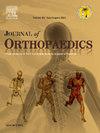股骨髋臼撞击髋关节镜术后围生期疼痛加重,可能不会恢复到孕前改善
IF 1.5
Q3 ORTHOPEDICS
引用次数: 0
摘要
目的探讨育龄女性髋关节镜治疗股骨髋臼撞击综合征(FAIS)及妊娠并发症的围手术期、妊娠期及术后预后。方法年龄18-44岁,接受单外科手术髋关节镜治疗FAIS的女性纳入研究。术后,对患者进行产科史、髋关节症状和术后妊娠经历的调查。受试者被分为无妊娠(1组),髋关节手术前至少怀孕一次,但手术后从未再次怀孕(2组),或髋关节手术后至少怀孕一次(3组)。髋关节疼痛强度用10分视觉模拟量表(VAS)报告,髋关节功能用改良的Harris髋关节评分(mHHS)报告。患者自我报告妊娠结局和并发症。结果85例患者入组,手术时平均年龄32.3±6.5岁。平均随访时间51.9±34.5个月。1组39例(45.9%),2组20例(23.5%),3组26例(30.6%)。术前和末次随访时mHHS组间差异无统计学意义(p = 0.95)。第3组受试者报告术后和妊娠后VAS均显著低于术前基线(p <;0.001)。69.2%和73.1%分别在妊娠晚期和产后报告髋关节疼痛加重。57.9%的人报告说,在调查完成时,她们的髋关节疼痛恢复到怀孕前的基线。结论育龄FAIS女性在髋关节镜检查后,不论妊娠时间与手术干预相关,均可预期临床改善。大多数在关节镜检查后怀孕的患者会经历围产期症状的复发。大多数但不是所有这些患者术后恢复到他们最初经历的最大改善水平。本文章由计算机程序翻译,如有差异,请以英文原文为准。
Pain worsens peripartum after hip arthroscopy for femoroacetabular impingement and may not return to pre-pregnancy improvement
Purpose
To assess hip symptomatology during the perioperative and peripregnancy periods and postoperative outcomes among reproductive age females undergoing arthroscopic treatment for femoroacetabular impingement syndrome (FAIS) and pregnancy complications in females after hip arthroscopy.
Methods
Females aged 18–44 years who underwent hip arthroscopy for the treatment of FAIS with a single surgeon were included in the study. Postoperatively, patients were surveyed regarding obstetric history, hip symptomology, and post-surgery pregnancy experiences. Subjects were classified as nulligravid (Group 1), pregnant at least once before hip surgery but never again following surgery (Group 2), or pregnant at least once following hip surgery (Group 3). Hip pain intensity was reported on a 10-point Visual Analog Scale (VAS) and hip function was reported using the modified Harris Hip Score (mHHS). Patients self-reported pregnancy outcomes and complications.
Results
85 patients were enrolled with a mean age of 32.3 ± 6.5 years at the time of surgery. Mean follow-up time was 51.9 ± 34.5 months. There were 39 subjects in Group 1 (45.9 %), 20 in Group 2 (23.5 %), and 26 in Group 3 (30.6 %). There were no significant inter-group differences in mHHS preoperatively or at final follow-up (p = 0.95). Group 3 subjects reported that both postoperative and post-pregnancy VAS remained significantly lower than the preoperative baseline (p < 0.001). 69.2 % and 73.1 % report worsened hip pain during the third trimester and postpartum, respectively. 57.9 % reported that their hip pain returned to the pre-pregnancy baseline by time of survey completion.
Conclusion
Females of reproductive age with FAIS can expect clinical improvements relative to their baseline after hip arthroscopy regardless of pregnancy timing relative to surgical intervention. A majority of patients who become pregnant post-arthroscopy experience a peripartum recurrence of their symptoms. Most but not all of these patients return to the level of maximal improvement they had initially experienced postoperatively.
求助全文
通过发布文献求助,成功后即可免费获取论文全文。
去求助
来源期刊

Journal of orthopaedics
ORTHOPEDICS-
CiteScore
3.50
自引率
6.70%
发文量
202
审稿时长
56 days
期刊介绍:
Journal of Orthopaedics aims to be a leading journal in orthopaedics and contribute towards the improvement of quality of orthopedic health care. The journal publishes original research work and review articles related to different aspects of orthopaedics including Arthroplasty, Arthroscopy, Sports Medicine, Trauma, Spine and Spinal deformities, Pediatric orthopaedics, limb reconstruction procedures, hand surgery, and orthopaedic oncology. It also publishes articles on continuing education, health-related information, case reports and letters to the editor. It is requested to note that the journal has an international readership and all submissions should be aimed at specifying something about the setting in which the work was conducted. Authors must also provide any specific reasons for the research and also provide an elaborate description of the results.
 求助内容:
求助内容: 应助结果提醒方式:
应助结果提醒方式:


